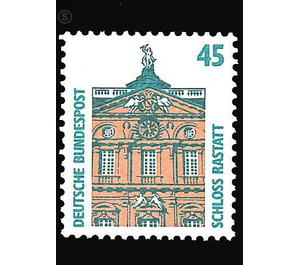Postage stamps: Places of interest - Germany / Federal Republic of Germany 1990 - 45 Pfennig
Theme: Architecture
| Country | Germany / Federal Republic of Germany |
| Issue Date | 1990 |
| Face Value | 45.00 |
| Color | brown white |
| Perforation | K 14 |
| Printing Type | indirect 2-color letterpress |
| Stamp Type | Postage stamp |
| Item Type | Stamp |
| Chronological Issue Number | 1341 |
| Chronological Chapter | GER-BRD |
| SID | 276102 |
| In 50 Wishlists | |
The Markgräfliches castle in Rastatt is one of the first Baroque palaces, which was built after the Thirty Years' War in Germany. Margrave Ludwig Wilhelm of Baden, the so-called "Turkslouis," had it erected to make his services as imperial field marshal and conqueror of the Turks widely visible in the Reich; The outdated residence of Baden-Baden, which had been badly damaged by the clashes with Louis XIV of France, no longer corresponded to the changed representations of the early 18th century. Like the French Sun King, Louis Wilhelm had plans drawn up by his architect not only for a new castle, but also for an extensive urban complex. In 1699, under the architect Domenico Egidio Rossi, the construction of the new building began in the Rhine plain and was completed after a few years. Model for Rossi, who had previously worked in Vienna, was the Italian-Austrian palace building. The monotonous row of window axes and the vigorously formed cornices bear witness to this. After the extinction of the Margrave House Baden-Baden the residence Rastatt 1771 reached the margraviate Baden-Durlach. In the castle the courtly life went out. The magnificent equipment was brought to Karlsruhe to the new Gesamtbadischer court or partially sold. Only rarely were the rooms used. It is precisely due to the circumstance of neglect that the wall-fixed equipment was preserved almost without damage. Along with moving pieces of furniture, the Administration of State Castles and Gardens succeeded in closing the gaps that had been created in recent years and giving the visitor an approximate idea of the original splendor. So today the castle is filled with life again and has become a small cultural-historical center with furnished showrooms. In addition to the castle museum are in the building also defense historical collections and a memorial to German freedom movements. (Text: Dr. Wolfgang Wiese, Conservator, State Palaces and Gardens, Oberfinanzdirektion Karlsruhe).


